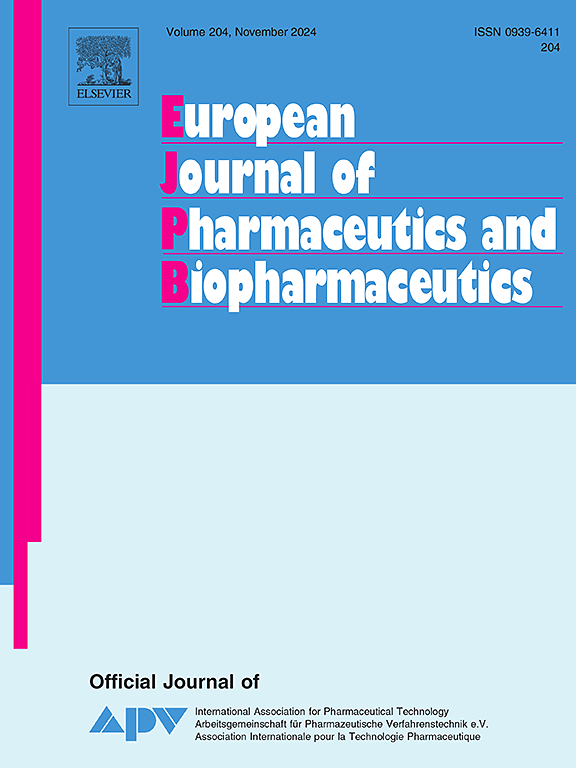Investigation of powder properties and application aspects impacting nasal deposition of spray-dried powders in a nasal cast
IF 4.4
2区 医学
Q1 PHARMACOLOGY & PHARMACY
European Journal of Pharmaceutics and Biopharmaceutics
Pub Date : 2025-02-14
DOI:10.1016/j.ejpb.2025.114666
引用次数: 0
Abstract
In this study, spray-dried formulations differing in morphology (spherical and wrinkled), surface polarity (hydrophilic and hydrophobic), and size (20–30 µm and 3 µm) were evaluated in a nasal cast to assess their deposition profiles. The objective was to identify how formulation properties and application aspects influence the deposition profile. For this purpose, the formulations were administered at different application angles (45° and 60°), fill weights (20 mg and 40 mg), and airflow rates (0 L/min and 15 L/min) in conjunction with a UDS powder device. The results indicate a more posterior deposition profile for 45° compared to 60° due to increased deposition in the turbinate region; conversely, deposition profiles between fill weights were comparable. Application with simultaneous airflow should be avoided because of an increasing postnasal fraction. No influence of morphology could be observed, but for the surface polarity an influence was apparent, if the powder was applied with a simulated inspiration. In these cases, a hydrophobic formulation was better dispersible than a hydrophilic formulation, which led to an increased postnasal fraction. A particle size for pulmonary application demonstrated comparable results to nasal formulations with respect to the turbinate deposition but exhibited a high postnasal fraction for hydrophobic formulations.

影响喷雾干粉鼻铸模鼻沉积的粉末性能及应用研究。
在这项研究中,在鼻腔模型中评估了不同形态(球形和褶皱)、表面极性(亲水性和疏水性)和尺寸(20-30 µm和3 µm)的喷雾干燥配方,以评估其沉积特征。目的是确定配方性质和应用方面如何影响沉积剖面。为此,配方以不同的应用角度(45°和60°),填充重量(20 mg和40 mg),气流速率(0 L/min和15 L/min)与UDS粉末装置一起施用。结果表明,由于鼻甲区域的沉积增加,与60°相比,45°时沉积轮廓更后;相反,不同充填重量之间的沉积剖面具有可比性。应避免同时使用气流,因为鼻后部分增加。没有观察到形貌的影响,但对表面极性的影响是明显的,如果粉末与模拟灵感应用。在这些情况下,疏水制剂比亲水制剂具有更好的分散性,这导致鼻后成分增加。肺应用的颗粒大小与鼻配方在鼻甲沉积方面表现出可比的结果,但疏水配方在鼻后表现出较高的分数。
本文章由计算机程序翻译,如有差异,请以英文原文为准。
求助全文
约1分钟内获得全文
求助全文
来源期刊
CiteScore
8.80
自引率
4.10%
发文量
211
审稿时长
36 days
期刊介绍:
The European Journal of Pharmaceutics and Biopharmaceutics provides a medium for the publication of novel, innovative and hypothesis-driven research from the areas of Pharmaceutics and Biopharmaceutics.
Topics covered include for example:
Design and development of drug delivery systems for pharmaceuticals and biopharmaceuticals (small molecules, proteins, nucleic acids)
Aspects of manufacturing process design
Biomedical aspects of drug product design
Strategies and formulations for controlled drug transport across biological barriers
Physicochemical aspects of drug product development
Novel excipients for drug product design
Drug delivery and controlled release systems for systemic and local applications
Nanomaterials for therapeutic and diagnostic purposes
Advanced therapy medicinal products
Medical devices supporting a distinct pharmacological effect.

 求助内容:
求助内容: 应助结果提醒方式:
应助结果提醒方式:


